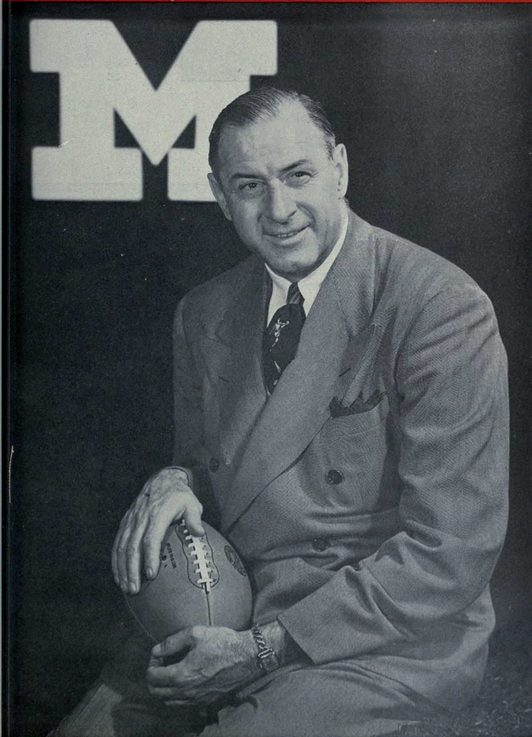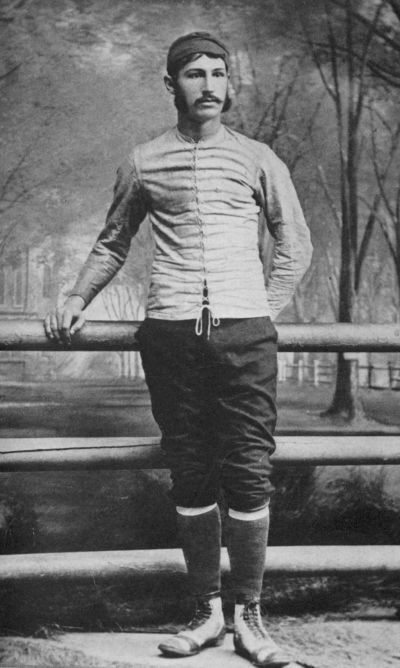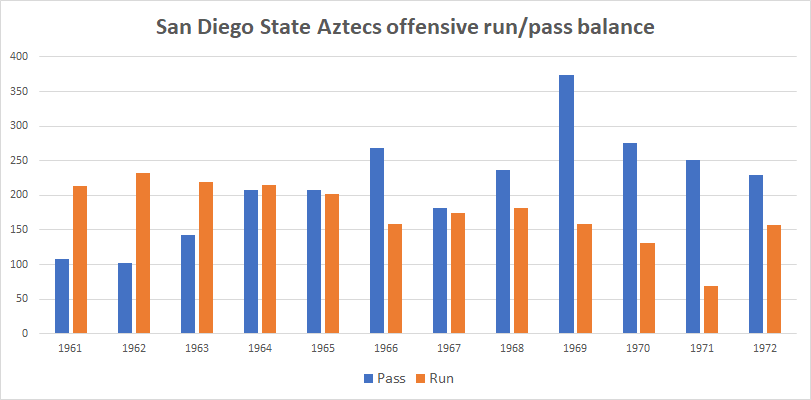|
Two-platoon System
The two-platoon system is a tactic in American football enabled by rules allowing unlimited substitution adopted during the 1940s. The "two platoons", offense and defense, are an integral part of the modern game today. History In its earliest iteration, American football -- like the sport of rugby whence it sprung -- featured squads of players alternating on offense and defense in continuous action without leaving the field. This one-platoon system was mandated by rule. Prior to 1932, a player removed during the first half could not return to the field until the second half, while a player removed in the second half was lost for the game.George C. Nilan, "It Can Never Happen Again: The New Rules Make Drastic Changes in the Game," ''Illustrated Football Annual, 1932.'' New York: Fiction House, 1932; pg. 84. With no limits to the size of a college football roster, a severe competitive advantage was thereby created for large collegiate football programs, which could send in multiple ... [...More Info...] [...Related Items...] OR: [Wikipedia] [Google] [Baidu] |
American Football
American football (referred to simply as football in the United States and Canada), also known as gridiron, is a team sport played by two teams of eleven players on a rectangular field with goalposts at each end. The offense, the team with possession of the oval-shaped football, attempts to advance down the field by running with the ball or passing it, while the defense, the team without possession of the ball, aims to stop the offense's advance and to take control of the ball for themselves. The offense must advance at least ten yards in four downs or plays; if they fail, they turn over the football to the defense, but if they succeed, they are given a new set of four downs to continue the drive. Points are scored primarily by advancing the ball into the opposing team's end zone for a touchdown or kicking the ball through the opponent's goalposts for a field goal. The team with the most points at the end of a game wins. American football evolved in the United States, ... [...More Info...] [...Related Items...] OR: [Wikipedia] [Google] [Baidu] |
Paul Dietzel
Paul may refer to: *Paul (given name), a given name (includes a list of people with that name) *Paul (surname), a list of people People Christianity *Paul the Apostle (AD c.5–c.64/65), also known as Saul of Tarsus or Saint Paul, early Christian missionary and writer *Pope Paul (other), multiple Popes of the Roman Catholic Church *Saint Paul (other), multiple other people and locations named "Saint Paul" Roman and Byzantine empire *Lucius Aemilius Paullus Macedonicus (c. 229 BC – 160 BC), Roman general *Julius Paulus Prudentissimus (), Roman jurist *Paulus Catena (died 362), Roman notary *Paulus Alexandrinus (4th century), Hellenistic astrologer *Paul of Aegina or Paulus Aegineta (625–690), Greek surgeon Royals *Paul I of Russia (1754–1801), Tsar of Russia *Paul of Greece (1901–1964), King of Greece Other people *Paul the Deacon or Paulus Diaconus (c. 720 – c. 799), Italian Benedictine monk *Paul (father of Maurice), the father of Maurice, Byzan ... [...More Info...] [...Related Items...] OR: [Wikipedia] [Google] [Baidu] |
One-platoon System
The one-platoon system, also known as iron man football, is a platoon system in American football where players play on both offense and defense. It was the result of smaller roster sizes in the early days of the game and rules that limited player substitutions, rules that are also standard procedure in many other sports but were eliminated in the 1940s as free substitution was legalized. The alternative system is the two-platoon system (or simply the ''platoon system''), which uses separate offensive and defensive units (three platoons if special teams is also counted). Each system was used at different times in American college football and in the National Football League. One-platoon football is seen in modern times mostly on lower-end and smaller teams at the high school and semi-pro levels, where player shortages and talent disparities require it; the system allows teams to play with a smaller roster than a two-platoon or multiple-platoon team, but because players are on the f ... [...More Info...] [...Related Items...] OR: [Wikipedia] [Google] [Baidu] |
The Free-Lance Star
''The'' () is a grammatical article in English, denoting persons or things already mentioned, under discussion, implied or otherwise presumed familiar to listeners, readers, or speakers. It is the definite article in English. ''The'' is the most frequently used word in the English language; studies and analyses of texts have found it to account for seven percent of all printed English-language words. It is derived from gendered articles in Old English which combined in Middle English and now has a single form used with pronouns of any gender. The word can be used with both singular and plural nouns, and with a noun that starts with any letter. This is different from many other languages, which have different forms of the definite article for different genders or numbers. Pronunciation In most dialects, "the" is pronounced as (with the voiced dental fricative followed by a schwa) when followed by a consonant sound, and as (homophone of pronoun ''thee'') when followed by a v ... [...More Info...] [...Related Items...] OR: [Wikipedia] [Google] [Baidu] |
3–4 Defense
In American football, the 3–4 defense is a common defensive alignment consisting of three down linemen and four linebackers. It is a called a "base defense" because it is the default defensive alignment used on "base downs" (1st and 2nd downs). However, defenses will readily switch to other defensive alignments (such as a nickel defense or a dime defense) as circumstances change. Alternatively, some defenses use a 4–3 defense. Overview The 3–4 defense incorporates three defensive linemen – two defensive ends and one nose tackle, who line up opposite the other team's offensive line. Those three players are responsible for engaging the other team's offensive line, allowing the four linebackers to either rush the quarterback or drop back into coverage, depending on the situation. While the role of the defensive linemen is fairly consistent, the linebackers allow for the flexibility and versatility of the 3–4 scheme, and give defensive coaches nearly limitless options t ... [...More Info...] [...Related Items...] OR: [Wikipedia] [Google] [Baidu] |
4–3 Defense
In American football, a 4–3 defense is a defensive alignment consisting of four down linemen and three linebackers. It is called a "base defense" because it is the default defensive alignment used on "base downs" (1st and 2nd downs). However, defenses will readily switch to other defensive alignments (such as a nickel defense or a dime defense) as circumstances change. Alternatively, some defenses use a 3–4 defense. History Early in the history of the NFL, teams stacked the defensive line of scrimmage with seven linemen, typically using a 7-diamond or the 7-box. With the liberalization of the forward passing rules in 1933, the defenses began to evolve along with the offensive changes, and by the later 1930s, the standard defense in the NFL and college was the 6–2. The successes of the T formation and the introduction of free substitution (abolishing the one-platoon system) in the 1940s led to the almost universal adoption by 1950 of the five-man line.''Total Footba ... [...More Info...] [...Related Items...] OR: [Wikipedia] [Google] [Baidu] |
Defensive Back
In gridiron football, defensive backs (DBs), also called the secondary, are the players on the defensive side of the ball who play farthest back from the line of scrimmage. They are distinguished from the other two sets of defensive players, the defensive linemen who play directly on the line of scrimmage, and the linebackers, who play in the middle of the defense, between the defensive line and the defensive backs. Among the defensive backs, there are two main types, cornerbacks, which play nearer the line of scrimmage and the sideline, whose main role is to cover the opposing team's wide receivers, and the Safety (gridiron football position), safeties, who play further back near the center of the field, and who act as the last line of defense. American defensive formations usually includes two of each, a left and right cornerback, as well as a strong safety and a free safety, with the free safety tending to play further back than the strong safety. In Canadian football, which ha ... [...More Info...] [...Related Items...] OR: [Wikipedia] [Google] [Baidu] |
Linebacker
Linebacker (LB) is a playing position in gridiron football. Linebackers are members of the defensive team, and line up three to five yards behind the line of scrimmage and the defensive linemen. They are the "middle ground" of defenders, playing closer to the line of scrimmage than the defensive backs (secondary), but farther back than the defensive linemen. As such, linebackers play a hybrid role and are often the most versatile players on the defensive side of the ball; they can be asked to play roles similar to either a defensive lineman (such as stopping the runner on a running play) or a defensive back (such as dropping back into pass coverage). How a linebacker plays their position depends on the defensive alignment, the philosophy of the coaching staff, and the particular play the offense may call. Linebackers are divided into middle linebackers, sometimes called inside linebackers, and outside linebackers. The middle linebacker, often called "Mike", is frequently ... [...More Info...] [...Related Items...] OR: [Wikipedia] [Google] [Baidu] |
Don Coryell
Donald David Coryell (October 17, 1924 – July 1, 2010) was an American football coach, who coached in the National Football League (NFL) first with the St. Louis Cardinals from 1973 to 1977 and then the San Diego Chargers from 1978 to 1986. Well known for his innovations to football's passing offense, commonly known as "Air Coryell", he was the first head coach to win more than 100 games at both the collegiate and professional level. Coryell was inducted into the Chargers Hall of Fame in 1986 and is a member of the College Football Hall of Fame. The Professional Football Researchers Association named Coryell to the PFRA Hall of Very Good Class of 2010. Early life Don Coryell was the youngest of four children, all boys, born to Julia and George Coryell in Seattle, Washington. Don initially had no middle name, but adopted David at his mother's suggestion, as the biblical story of David and Goliath was his favorite as a child. Coryell graduated from Lincoln High School i ... [...More Info...] [...Related Items...] OR: [Wikipedia] [Google] [Baidu] |
Google Books
Google Books (previously known as Google Book Search, Google Print, and by its code-name Project Ocean) is a service from Google Inc. that searches the full text of books and magazines that Google has scanned, converted to text using optical character recognition (OCR), and stored in its digital database.The basic Google book link is found at: https://books.google.com/ . The "advanced" interface allowing more specific searches is found at: https://books.google.com/advanced_book_search Books are provided either by publishers and authors through the Google Books Partner Program, or by Google's library partners through the Library Project. Additionally, Google has partnered with a number of magazine publishers to digitize their archives. The Publisher Program was first known as Google Print when it was introduced at the Frankfurt Book Fair in October 2004. The Google Books Library Project, which scans works in the collections of library partners and adds them to the digital invent ... [...More Info...] [...Related Items...] OR: [Wikipedia] [Google] [Baidu] |
Special Teams
In American football, the specific role that a player takes on the field is referred to as their "position". Under the modern rules of American football, both teams are allowed 11 players on the field at one time and have "unlimited free substitutions", meaning that they may change any number of players during any "dead ball" situation. This has resulted in the development of three task-specific "platoons" of players within any single team: the offense (the team with possession of the ball, which is trying to score), the defense (the team trying to prevent the other team from scoring, and to take the ball from them), and the so-called 'special teams' (who play in all kicking situations). Within these three separate "platoons", various positions exist depending on the jobs that the players are doing. Offense In American football, the offense is the team that has possession of the ball and is advancing toward the opponent's end zone to score points. The eleven players of the offen ... [...More Info...] [...Related Items...] OR: [Wikipedia] [Google] [Baidu] |
Bloomington, Indiana
Bloomington is a city in and the county seat of Monroe County, Indiana, Monroe County in the central region of the U.S. state of Indiana. It is the List of municipalities in Indiana, seventh-largest city in Indiana and the fourth-largest outside the Indianapolis metropolitan area. According to the Monroe County History Center, Bloomington is known as the "Gateway to Scenic Southern Indiana". The city was established in 1818 by a group of settlers from Kentucky, Tennessee, the Carolinas, and Virginia who were so impressed with "a haven of blooms" that they called it Bloomington. The population was 79,168 at the 2020 United States census, 2020 census. Bloomington is the home to Indiana University Bloomington, the flagship campus of the Indiana University, IU System. Established in 1820, IU Bloomington has 45,328 students, as of September 2021, and is the original and largest campus of Indiana University. Most of the campus buildings are built of Indiana limestone. Bloomington has ... [...More Info...] [...Related Items...] OR: [Wikipedia] [Google] [Baidu] |


.png)

